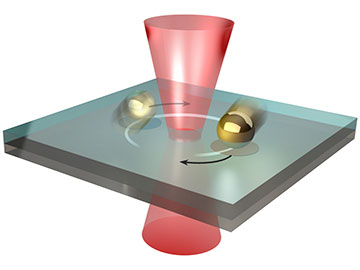
Researchers developed light-driven opto-thermocapillary nanomotors that operate on solid substrates. The schematic shows gold nanoparticles rotating around the laser beam. [Image: The University of Texas at Austin]
Researchers from the University of Texas at Austin, USA, have created light-driven nanomotors that can operate on a solid substrate under ambient conditions, effectively avoiding any interference from Brownian motion (ACS Nano, doi: 10.1021/acsnano.1c09800). Previous motors of their kind required immersion in a liquid environment, limiting their precise control and range of applications.
The novel nanomotors could potentially be used for air quality measurement, drug delivery and mechanical power for tiny drones and other miniature devices.
Miniaturizing motors
Micromotors activated by light have several advantages over those driven by chemical reactions, including remote operation as well as excellent temporal and spatial control. Recent efforts have revolved around shrinking the motors even further, in the pursuit of molecular machines that can control mechanical forces and motions at the nanometer scale.
“Similar to Moore’s Law, where people are always pursuing microelectronics with smaller size and higher storage density, the realization of motors at the micro- and nanoscale is essential for us to understand the physical principles and build functional devices at a smaller scale,” said first author Jingang Li. “This will in turn bring new possibilities for a wide range of applications in different fields, such as biomedical engineering and robotics.”
However, further miniaturization of optical motors down to the nanoscale has proven challenging. The main obstacle has been the strong Brownian motion of the nanoscale object, since the motors were designed to operate in water or other solutions.
Synergy between forces
To solve this issue, Li and his colleagues built the first ever solid-state optical nanomotor. It consists of a thermally responsive layer of solid cetyltrimethylammonium chloride (CTAC) sandwiched between a glass substrate and 80-nm gold nanoparticles.
First, a 660-nm laser illuminates the motor, and the heat induces a phase transition in the CTAC from a crystalline structure to a quasi-liquid phase. The phase transition reduces friction and generates thermocapillary stress at the interface between the gold nanoparticles and CTAC. Lastly, the synergy between optical and thermocapillary forces causes the gold nanoparticles to rotate steadily in a circular orbit around the laser beam.
The researchers observed the rotation of the nanomotor through a microscope, analyzing the rotation speed and rotation radius. They also calculated the work done by the motor to obtain the energy-conversion efficiency, which they estimated to be approximately 10-14 at a laser power between 5 and 10 mW—comparable with state-of-the-art microscopic optical engines.
Nanotechnological applications
Next, Li aims to improve the capabilities of the solid-state nanomotor by making it more robust and enhancing its energy efficiency. Once the design is optimized, he foresees several real-world nanotechnological applications, especially given that the nanomotor is achieved with a simpler optical setup compared to previous devices.
“With the ability to convert light into energy and perform work, as well as the unique capability to rotate on the solid substrate, our nanomotors can be potentially used to detect air quality, transport objects for solid-state devices and replace batteries to provide energy in some nanodevices,” said Li.
